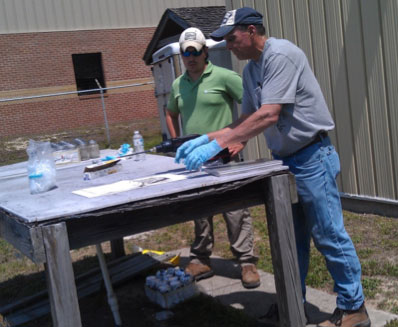 SACAL provides expert resources experienced in remedial investigations and feasibility studies (RI/FS) and performs remedial design and remedial actions (RD/RA) at petroleum contaminated sites. The objective of a remedial design and remedial action is to clean up the contaminated site to a level that is safe for human health and the environment. SACAL provides the labor, including, engineers, scientists, specialists, technicians, equipments, materials, and technology necessary to remediate petroleum contaminated site(s). In order to develop and implement a site specific remedial action, SACAL performs the following scope of work:
SACAL provides expert resources experienced in remedial investigations and feasibility studies (RI/FS) and performs remedial design and remedial actions (RD/RA) at petroleum contaminated sites. The objective of a remedial design and remedial action is to clean up the contaminated site to a level that is safe for human health and the environment. SACAL provides the labor, including, engineers, scientists, specialists, technicians, equipments, materials, and technology necessary to remediate petroleum contaminated site(s). In order to develop and implement a site specific remedial action, SACAL performs the following scope of work:
- Review site information
- Develop remedial alternatives
- Perform detailed analysis of remedial alternatives
- Compare alternatives against each other and select best appropriate alternative
- Develop Project Implementation Plan
- Perform site remediation and restoration
- Review of Site information
The objective of this review is to determine the nature and extent of contamination; evaluate the site information, chemical(s) released, extent of environmental media impacted-surface/subsurface, risks associated with the release, potential migration pathways and receptors, and etc. and then develop a preliminary remedial action level. Review will include site visit.
- Development of Remedial Alternatives
Remedial alternatives will be developed to meet the remedial action objectives for each impacted media of interest, such as air, soil or groundwater. The remedial actions may include, singly or a combination of containment, institutional/engineering control, treatment, excavation, or pumping
- Perform Detailed Analysis of Remedial Alternatives
The detailed analysis of alternatives will include the analysis and presentation of the relevant information necessary to identify cost effective means of achieving final corrective action goals. During the detailed analysis, each alternative will be assessed against eight evaluation criteria. The criteria are:
- Overall Protection of human health and the environment
Alternatives will be assessed as to whether they can protect human health and the environment from unacceptable risks posed by hazardous substances at the site by eliminating, reducing or controlling exposures to levels established during development of remediation goals.
- Compliance with Applicable or Relevant and Appropriate Requirements
Alternatives will be assessed as to whether they attain applicable or relevant and appropriate standards, criteria and requirements of environmental and public health laws.
- Long-term effectiveness and permanence
Alternatives long-term effectiveness and permanence afforded will be assessed along with the degree of certainty that the alternative will prove successful.
- Reduction of toxicity, mobility and volume
The degree to which alternatives employ treatment that reduces toxicity, mobility or volume of contaminants will be assessed.
- Short-term Effectiveness
The short-term impacts of the alternatives during the construction and implementation phase and until the objectives of the remedial action have been met, will be assessed.
- Implement ability
The technical, logistical and administrative feasibility of implementing the alternatives will be assessed by considering factors such as:
– degree of difficulty associated with construction and operation of the alternative;
– expected operational reliability of the alternative;
– ease of undertaking additional remedial action;
– ability to monitor the effectiveness of the remedy;
– activities needed to coordinate with interested parties
– capacity and location of adequate treatment, storage, and disposal services
– availability of necessary equipment, services, and materials
– safety and community relation issues
- Cost
The direct and indirect capital costs and the annual operation and maintenance costs associated with the alternatives will be assessed.
- Community Acceptance.
The interest of the community will be factored in evaluating alternatives
- Compare alternatives against each other and select best appropriate alternative
The results of the assessment will be arrayed to compare the alternatives and identify the key trade-offs among them. A report of the analysis and recommendation of alternative remedial technology will be provided for approval prior to implementation.
- Develop Project Implementation Plan
The following work implementation plans will be developed prior to mobilization to site
– Waste handling/disposal/testing plan
– Excavation and material handling plan
– Spill and discharge control plan
– Construction quality control plan
– Sampling and analysis/quality assurance plan
– Erosion and sediment control plan
– Health and safety plan
– Project schedule
- Perform site remediation and restoration
Mobilize personnel, equipment, materials and supplies to site and begin construction.
- Compliance Monitoring
SACAL performs monitoring to ensure that remedial action goals are satisfied.
